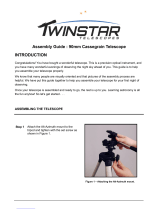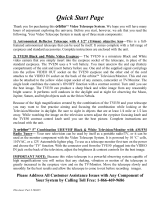
A telescope is an instrument that collects and focuses light. The nature of the optical design determines
how the light is focused. Some telescopes, known as refractors, use lenses, .and other telescopes, known
as reflectors (Newtonians), use mirrors.
Developed in the early 1600s, the refractor is the
oldest telescope design. It derives its name from
the method it uses to focus incoming light rays.
The refractor uses a lens to bend or refract incom-
ing light rays, hence the name (see Figure 3-1).
Early designs used single element lenses. How-
ever, the single lens acts like a prism and breaks
light down into the colors of the rainbow, a phe-
nomenon known as chromatic aberration. To get
around this problem, a two-element lens, known
as an achromat, was introduced. Each element has
a different index of refraction allowing two differ-
ent wavelengths of light to be focused at the same
point. Most two-element lenses, usually made of
crown and flint glasses, are corrected for red and
green light. Blue light may still be focused at a
slightly different point.
A Newtonian reflector uses a single concave mir-
ror as its primary. Light enters the tube traveling
to the mirror at the back end. There light is bent
forward in the tube to a single point, its focal point.
Since putting your head in front of the telescope to
look at the image with an eyepiece would keep the
reflector from working, a flat mirror called a diago-
nal intercepts the light and points it out the side of
the tube at right angles to the tube. The eyepiece
is placed there for easy viewing.
Newtonian Reflector telescopes replace heavy
lenses with mirrors to collect and focus the light,
providing much more light-gathering power for
the money spent. Because the light path is inter-
cepted and reflected out to the side, you can have
focal lengths up to 1000mm and still enjoy a
telescope that is relatively compact and portable.
A Newtonian Reflector telescope offers such impressive
light-gathering characteristics you can take a serious
interest in deep space astronomy even on a modest
budget. Newtonian Reflector telescopes do require
more care and maintenance because the primary
mirror is exposed to air and dust. However, this
small drawback does not hamper this type of
telescope’s popularity with those who want an
economical telescope that can still resolve faint,
distant objects.
9
Figure 3-1
A cutaway view of the light path of the
Refractor optical design
Figure 3-1
Cutaway view of the light path of the Newtonian
TELESCOPE BASICS























